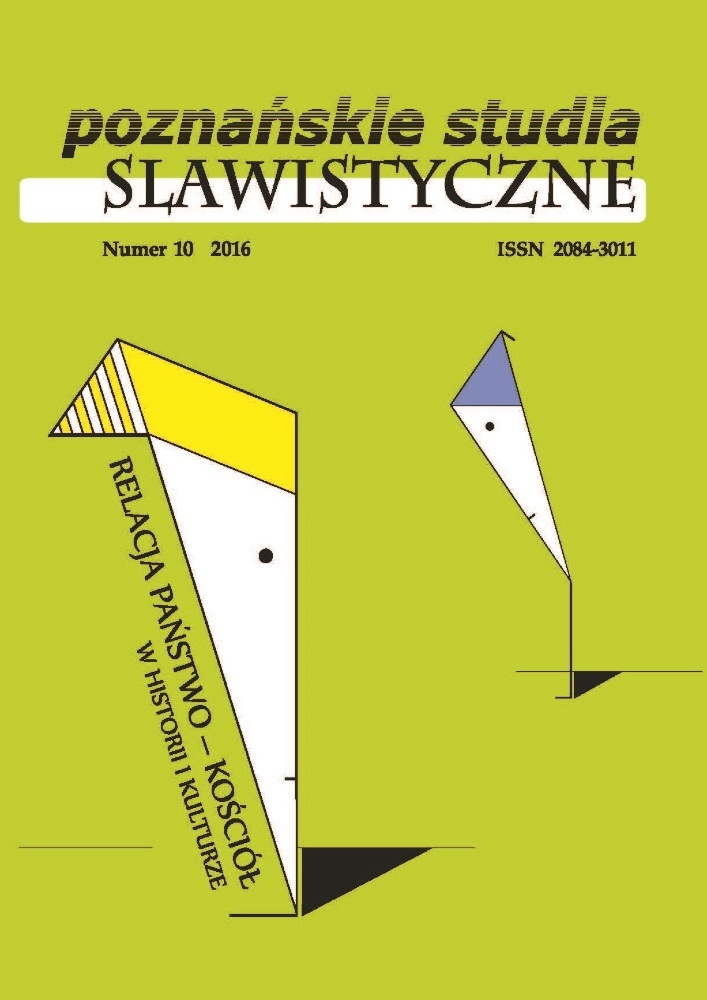Abstract
This paper is based on the earlier works of the author (incurred mainly on the analysis of the press of state and Church provenance), surveys of sociologists of religion, and findings of other researchers dealing with the issues of the Serbian Orthodox Church. Several characteristic points could be drawn that marked the history of the Church in the late 80s and throughout the 90s: the Church’s return from the margins and its more significant presence in society; accelerated process of desecularization; complicated relationship to authorities, ranged from the first closeness to the complete break and disappointment over unfulfilled expectations of the Church; refusal to admit the divisions and the creation of new states formed into the wars on 90s, which for the Church constituted acts of violent secession to detriment of the Serbian people; negative attitudes to the West, ecumenism, Vatican and interfaith dialogue; efforts to resolve the issue of schism within the Church; and growing internal contradictions in the episcopate. Entering unprepared for transition processes that led from one political system to another, followed by the wars and the collapse of the state, and movements into the Church, the Serbian Orthodox Church has tried to oscillate between maintenance of the traditional role of the national Church, and a gradual adjustment to the changes, in aim to avoid major consequences for ecclesiastical organization.
References
Agadjanian A., 2001, Public Religion and the Quest for National Ideology: Russia’s Media Discourse, „Journal for the Scientific Study of Religion” br. 3, sv. 40, str. 351–365.
Ahtik M., 2004, Klerikalizacija Srbije, „Republika” br. 340–341, sv. XVI, 1–30, septembar 2004. <http://www.republika.co.rs/340–341/19.html>, 5.09.2015.
Blagojević M., 1993, Jugoslovenski kontekst: sekularizacija i desekularizacija, „Gradina” br. 10–12, str. 209–218.
Blagojević M., 1994, Vezanost ljudi za religiju i crkvu na pravoslavno homogenim prostorima, u: Religija – rat – mir, ur. B. Đurović, Niš, str. 207–221.
Blagojević M., 2003, Religijska situacija u SR Jugoslaviji od kraja 80-tih do početka novog veka, „Teme” br. 3, sv. 27, str. 411–436.
Blagojević M., 2008, Desecularization of Contemporary Serbian Society, „Religion in Eastern Europe” br. 1, sv. XXVIII, str. 37–50.
Bogomilova N., 2005, The Religious Situation in Contemporary Bulgaria, and in Serbia and Montenegro: Differences and Similarities, „Religion in Eastern Europe” br. 4, sv. XXV, str. 1–20.
Đorđević B.D., 2005, Nekoliko razmišljanja o našoj crkvi, u: Peščanik FM – Zašto se u crkvi šapuće, ur. S. Lukić, S. Vuković, br. 3, str. 31.
Đorđević B.D., Đurović B., 1993, Sekularizacija i pravoslavlje: slučaj Srba, „Gradina” br. 10–12, str. 219–224.
Đorđević D.B., Milošević Z., 1994, Pravoslavlje, rat i stradanje, u: Religija – rat – mir, ur. B. Đurović, Niš, str. 71–81.
Gredelj S., 1999, Klerikalizam, etnofiletizam, antiekumenizam i (ne)tolerancija, „Sociologija” br. 2, sv. XLI, str. 143–164.
Ilić A., 2004–2005, Church and State Relations in Present-day Serbia, „Religion in Eastern Europe” br. 1, sv. XXV, str. 35–36, br. 2, str. 40–57.
Lelkes O., 2006, Tasting freedom: Happiness, religion and economic transition, „Journal of Economic Behavior & Organization” br. 2, sv. 59, str. 173–194.
Malešević M., 2006, Pravoslavlje kao srž „nacionalnog bića” postkomunističke Srbije, u: Svakodnevna kultura u postsocijalističkom periodu u Srbiji i Bugarskoj – Balkanska transformacija i evropska integracija, ur. Z. Divac, br. 22, Beograd, str. 99–121.
Marković S.M., 1998, Tajna Kosova, „Hrišćanska misao” br. 6, Srbinje–Beograd–Valjevo–Minhen.
Pavle patr., 1991, Pismo lordu Karingtonu, „Pravoslavlje” br. 591, 1.11.1991, str. 1.
Powers F.G., 1998, Religion, Conflict and Prospect for Peace in Bosnia, Croatia and Yugoslavia, u: Religion and the War in Bosnia, ur. P. Mojzes, Atlanta, br. 3, str. 218–245.
Radic R., Vukomanovic M., 2014, Religion and Democracy in Serbia since 1989: The Case of the Serbian Orthodox Church, u: Religion and Politics in Post-Socialist Central and Southeastern Europe Challenges since 1989, ur. S.P. Ramet, London, str. 180–211.
Radić R., 1995, Srpska pravoslavna crkva u poratnim i ratnim godinama (1980–1995). Crkva i „srpsko pitanje”, „Republika” br. 121–122, str. I–XXIV.
Radić R., 2000, Crkva u politici i politika u Crkvi, u: Srpska elita, ur. O. Milosavljević, R. Radić, O. Savić, Beograd, str. 39–83.
Reljić S., 1999, Portret: vladika Atanasije (Jevtić), „NIN” br. 2544, <http://www.nin. co.rs/arhiva/2544/7.html>, 30.10.2015.
Savezni zavod za statistiku, 1993, Stanovništvo: popis stanovništva, domaćinstava, stanova i poljoprivrednih gazdinstava u 1991. godini. 2, Veroispovest: podaci po naseljima i opštinama, Beograd.
Tijanić A., 1986, Kraj mita o pravoslavnoj Srbiji, u: Povratak bogova, specijalno izdanje lista „Duga”, april, str. 4–9.
Tomanić M., 2001, Srpska crkva u ratu i ratovi u njoj, Beograd.
Vratuša-Žunjić V., 1995, Razvoj religija rat, Beograd.
Vrcan S., 1986, Od krize religije k religiji krize, Zagreb.
License

This work is licensed under a Creative Commons Attribution-NoDerivatives 4.0 International License.
